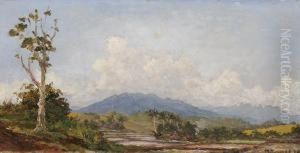Mas Pirngadi Paintings
Mas Pirngadi is a notable figure in the early 20th-century Indonesian art scene, whose life and work significantly contributed to the development of modern art in the country. Born in 1904 in Medan, North Sumatra, Indonesia, Pirngadi was a pioneering artist whose career, though brief, was marked by a profound exploration of socio-political themes and a distinctive approach to form and color that set him apart from his contemporaries.
In the early years of his career, Pirngadi was deeply influenced by the socio-political climate of Indonesia, which was then under Dutch colonial rule. This influence is evident in his works, which often depicted the harsh realities of life under colonialism, the beauty of the Indonesian landscape, and the daily lives of its people. His art was not only a reflection of the cultural and social environment of Indonesia but also a commentary on the struggles for independence and identity.
Pirngadi's style evolved over his short career, showing influences from European modernism, which he blended with local artistic traditions and motifs. This synthesis resulted in a unique visual language that was both universal in its appeal and deeply rooted in Indonesian culture. He was known for his bold use of color and form, which helped to convey complex narratives and emotions in his works.
Despite his promising career, Mas Pirngadi's life was tragically cut short when he died in 1936 at the age of 32. His early death meant that his body of work was relatively limited, yet his influence on Indonesian art has been lasting. Pirngadi is remembered as a trailblazer who opened up new possibilities for the expression of national identity and social critique through art. His legacy continues to inspire generations of Indonesian artists, and his works are celebrated for their contribution to the cultural heritage of Indonesia.
Mas Pirngadi's art and life story offer a poignant insight into the role of art in society and the power of creativity in challenging and transforming our understanding of the world. Despite the brevity of his career, his impact on the Indonesian art scene is a testament to the enduring nature of his vision and the depth of his talent.
